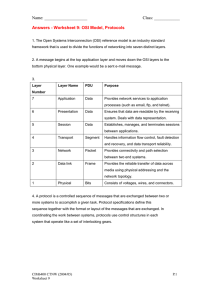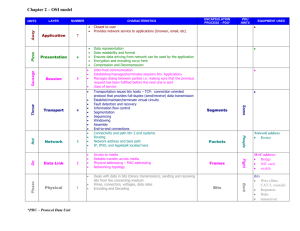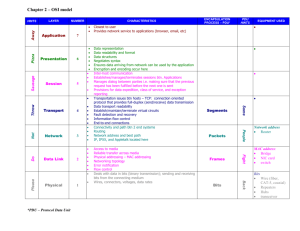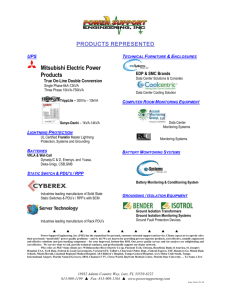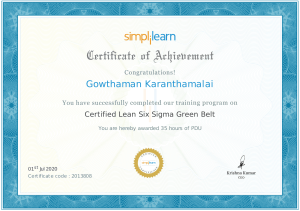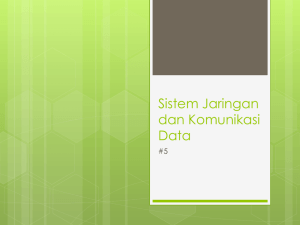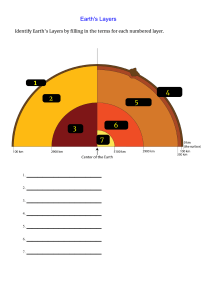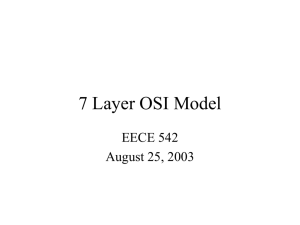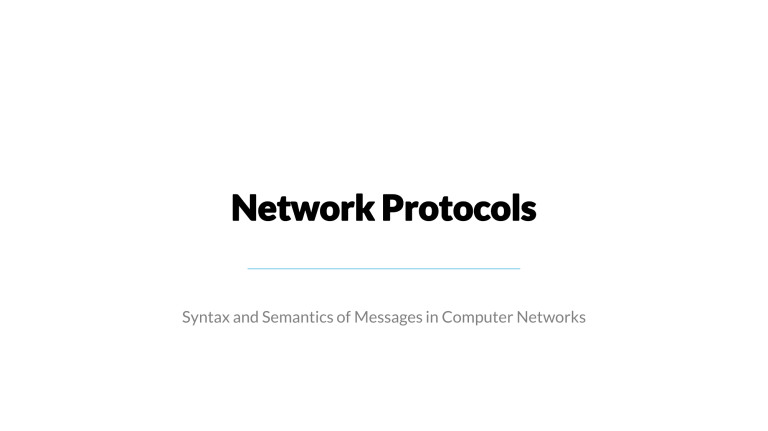
Network Protocols Syntax and Semantics of Messages in Computer Networks Objectives What will be covered in this lecture? • What is a network protocol? • What is a protocol data unit? • How efficient is a network protocol? • What are the OSI and the Internet layered protocol models? 2 T. Landolsi | Computer Networks The Internet Internet Network of communicating end systems • Internet = large and complex engineered system − billions of interconnected devices called end systems or hosts − end systems exchange msg. in the form of packets, hence: Internet = Packet Switching Network − complexity requires modular design and well-defined standards − IETF, ISO, IEEE developed standard ways of communication − divided networking into modules of functions called layers − introduced standard protocols for each layer • HTTP, TCP, IP, IEEE802.3, IEEE802.11… 3 T. Landolsi | Computer Networks Network Protocols What is a network protocol and what does it specify? • Protocol = Set of rules governing communication between network devices • Network devices communicate by exchanging messages e.g. request and response messages • Messages divided into packets known as protocol data units or PDUs • Protocols specify PDU structure and define syntax, semantics, and timing of messages − syntax format of PDU and order of its components − semantics meaning of PDU components − timing what network devices need to do, and when 4 T. Landolsi | Computer Networks Analogy • We “shake hands” before communicating • Human communication protocol • 5 T. Landolsi | Computer Networks 1. greet request to communicate 2. greet back response to request 3. communicate TCP famous three-way handshake 1. connection setup request msg. 2. connection setup response msg. 3. communicate Layered Protocol Models OSI 7-layer Model vs. TCP/IP 5-layer Model Layered Protocols Creating stack of protocols to handle networking functions efficiently • Complexity of networking tasks → engineers must follow modular design − one “super” protocol for everything won’t work! − must group similar functions together into layers − each layer will define and run its own protocol • Layering allows concept of service model − layer (𝑖) gives service to layer (𝑖 + 1) − layer (𝑖) gets service from layer (𝑖 − 1) − change in one layer won’t affect other layers 7 T. Landolsi | Computer Networks Internet Model vs. OSI Model Internet or TCP/IP model is a 5-layer model and OSI reference model is a 7-layer model • IETF defines 5-layer internet model: − Application layer or AL = L5: provides interface to user − Transport layer or TL = L4: provides AL with reliable service if needed − Network layer or NL = L3: delivers PDUs from one network to another − Link layer or LL = L2: delivers PDUs from one node to adjacent node − Physical layer or PHY = L1: converts PDU bits into physical signals • ISO added two extra layers between AL and TL to define OSI model: − Presentation layer: provide data encryption, compression, etc. − Session layer: session setup, teardown, synchronization, etc. 8 T. Landolsi | Computer Networks Logical Connections between Layers peer layers appear “logically connected” • Src. and dest. hosts exchange messages − if msg. is too large → they break it into packets • AL on src. host is peer to AL on dest. host − same for TL, NL layers − peer layers talk same language i.e. same protocol − their PDU formats are identical − peer layers appear logically connected − underlying layers abstract whole network infrastructure for upper layer − e.g. AL need not worry about what TL, NL, LL look like or what protocols they use 9 T. Landolsi | Computer Networks Protocol Data Unit How to carry large messages over the Internet? Example of PDU Structure • End systems exchange msg. in the form of packets, header • Packets are known as protocol data units or PDUs • PDU Header + Payload + Trailer payload − Payload important data to be delivered − Header + Trailer overhead needed to deliver payload − Header contains source and destination addresses − Trailer not always present in PDU 10 T. Landolsi | Computer Networks header payload trailer Layer-Specific Devices and PDU Names Different devices handle different layers’ PDUs with unique formats and names • Layer-specific PDU names: − AL PDU is called Message − TL PDU is called Segment − NL PDU is called Datagram − LL PDU is called Frame • Different network devices handle different layers − L3 routers handle NL datagrams − L2 Ethernet switches handle frames − L1 modems handle physical signals 11 T. Landolsi | Computer Networks Protocol Data Unit and Efficiency Creating protocols that perform needed functions without wasting resources Protocol Efficiency Protocol efficiency Ratio of payload size to total PDU size • Protocol efficiency: 𝜂𝑝 = • Example-1: Ethernet has good efficiency 𝐿𝑝 𝐿𝑝 + 𝐿𝑜ℎ − overhead size results in protocol efficiency − overhead size results in protocol efficiency • Tradeoff − 𝐿𝑝 = 1500 bytes − 𝐿𝑜ℎ = 14 + 4 bytes 𝜂𝑝 = 1500 ≈ 98.8% 1500 + 18 • Example-2: ATM has bad efficiency − OH too small → not enough for protocol to function − 𝐿𝑝 = 48 bytes − OH too large → reduces protocol efficiency − 𝐿𝑜ℎ = 5 bytes 𝜂𝑝 = 13 T. Landolsi | Computer Networks 48 ≈ 90.5% 48 + 5
